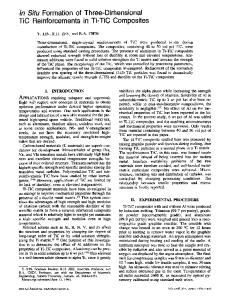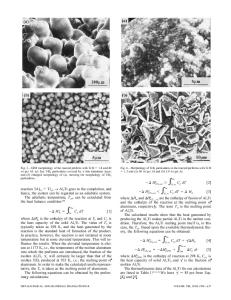Mechanism of TiC formation in Al/TiC in situ metal-matrix composites
- PDF / 1,468,009 Bytes
- 3 Pages / 597 x 774 pts Page_size
- 21 Downloads / 362 Views
Fig. 1--Optical micrograph of an in situ processed and cast A1-5.8 wt pct Cu - 0.2 wt pct Mg - 0.3 wt pct Mn + 4.5 vol. pct TiC alloy.
15.0
I
I
I
I
I
I
I
I
I
I
b
c
A
7.5
0.0
190 300 410 520 630 740 850 960 1070 11801290 Temperature (*C)
(a) 15.0
--I,'-
I
I
I
I
I
I
I
I
I
I
I
I
I
I
I
I
I
I
I
1
7.5
0.0
I
190
300 410 520 630 740 850 960 1070 1180 1290 Temperature (~
(b) Fig. 2 - - T h e DTA thermograms for AI-6 wt pct Ti powders mixed with graphite flakes (a) during heating at 20 K/min and (b) during cooling at 20 K/rain. VOLUME 24A, DECEMBER 1993--2803
only one peak can be identified. The peak temperature is at 933 K (660 ~ which is the freezing point of a pure aluminum. This suggests that practically all the Ti in the alloy melt was completely reacted with the carbon dispersed in the melt during heating. Figure 3 shows scanning electron microscopy (SEM) micrographs of the sample following the DTA experiment. Figure 3(a) shows an aluminum droplet approximately 100/xm in diameter surrounded by the excess graphite powders. Within the alloy droplet, clusters of TiC particles are present and one such region is shown in Figure 3(b) at a higher magnification. It is observed that the majority of the fine TiC particles are equiaxed; the finest particles of the order of 0 . 2 / x m appear spherical, while the large particles of the order of 0.5 /xm and greater are faceted. These observations of the morphology and the size of the TiC particles are quite different from the microstructure observed in the in situ processed materials (Figure 1) where the TiC particles tend to be faceted and their average size is on the order of a few microns. The microstructure of the DTA samples reveals several interesting aspects which shed some light on the
(a)
mechanisms involved in the in situ reaction process. First, all TiC particles within the matrix are significantly finer than the original graphite particles used in the mixture. Figure 4 shows the typical size and morphology of the carbon particles. The TiC particles are less than 0.5/xm, while the starting carbon particles are as large as 5 /zm. Second, neither unreacted cores nor surface reaction zones in the carbon particles which were in contact with the metal droplets were observed. Third, and more importantly, the fine TiC particles are not only round in shape but also are relatively uniform in size which strongly suggests that the formation of TiC is achieved via a mechanism of multiple nucleation and growth of TiC in situ from the carbon-saturated A1-Ti melt during isothermal holding. The fine submicron-size carbides with a narrow size distribution suggest that nucleation is easier than growth. Nucleation would require the dissolution and rapid diffusion of carbon from the large graphite flakes into the melt, while growth of the carbides would be controlled by the diffusion of the lower diffusivity species. It is believed that diffusivity of Ti at the processing temperature of --1533 K (1260 ~ is lower than that of carbon, and thus,
Data Loading...











